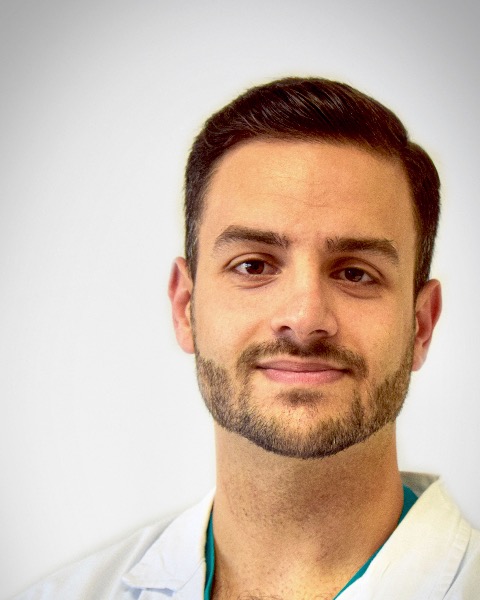Back
Poster, Podium & Video Sessions
Moderated Poster
MP27: Prostate Cancer: Advanced (including Drug Therapy) I
MP27-02: Not All Adverse Pathology Features Are Equal: Identifying Optimal Candidates For Adjuvant Radiotherapy Among Patients With Adverse Pathology at radical Prostatectomy
Saturday, May 14, 2022
10:30 AM – 11:45 AM
Location: Room 222
Elio Mazzone*, Giorgio Gandaglia, Armando Stabile, Milan, Italy, Nicola Fossati, Andrea Gallina, Lugano, Switzerland, Emanuele Zaffuto, Marta Picozzi, Francesco Barletta, Simone Scuderi, Riccardo Leni, Luigi Nocera, Gabriele Sorce, Francesco Pellegrino, Giuseppe Rosiello, Umberto Capitanio, Alessandro Larcher, Milan, Italy, Roberta Lucianò, Milano, Italy, Alessia Cimadamore, Ancona, Italy, Federico Dehò, Varese, Italy, Rodolfo Montironi, Ancona, Italy, Pierre I. Karakiewicz, Montreal, Canada, Shahrokh F. Shariat, Vienna, Austria, Francesco Montorsi, Alberto Briganti, Milano, Italy

Elio Mazzone, MD (he/him/his)
San Raffaele Hospital
Poster Presenter(s)
Introduction: The role of adjuvant radiotherapy (aRT) in patients with adverse pathology features is still debated due to the low rate of enrolment of such patients in RCT comparing aRT vs. early salvage radiotherapy (sRT). A recent retrospective analysis reported a potential benefit associated with aRT for patients with adverse pathology features. We hypothesized that not all the patients with adverse pathology may benefit from aRT and sRT may be considered in a subgroup of men without aggressive features.
Methods: Overall, 1,328 with adverse pathology features (i.e. Gleason Grade [GG] 4-5 with =pT3a stage and/or lymph node invasion [LNI]) out of 8,362 patients treated with RP at a single center between 1987 and 2020 were identified. Only patients with follow-up >36 months, absence of PSA persistence and =6 positive nodes were included (n=682). Patients were stratified according to aRT vs. observation with or without sRT. The primary endpoint was overall mortality (OM). Multivariable Cox regression model tested the impact of adverse pathology features on OM. Based on Cox-derived coefficients, a score was assigned to each adverse pathology feature (1 point for pT3b; 2 for GG 5 or 1-2 positive nodes; 3 for >2 positive nodes). Patients were stratified in low (0-1 points), intermediate (2-3 points) and high (4-5 points) risk groups. The probability of receiving aRT was weighted trough an inverse-probability of treatment weighting propensity score adjusted for the presence of positive surgical margins, PSA, year of surgery and age. The resulting weight was used as propensity adjustment in multivariable Cox regression models examining the impact of aRT on OM after adjusting for age, sRT and adjuvant or salvage hormonal therapy (HT). The impact of aRT was tested for each risk subgroup.
Results: Of 682 patients, 438 (64%) vs. 79 (12%) vs 167 (24%) patients received aRT vs sRT vs observation. Median follow-up for survivors was 116 months. A total of 65 patients died during follow-up. The overall 10-year OM-free survival rate was 90%. At multivariable Cox regression models, the presence of >2 positive nodes was the strongest predictor of OM (HR 2.8, p<0.001). After stratification according to risk groups, 75 (11%), 434 (63%) and 175 (26%) patients were included in low, intermediate and high-risk groups. Cox-derived KM depicted comparable 10-year OM-free survival in low and intermediate risk patients (all p=0.2) treated with aRT or observation +/- sRT. In the high-risk group, use of aRT was associated with significant improvement in 10-yr OM-free survival compared to observation +/- sRT (86 vs 73%, p=0.04).
Conclusions: Among patients with adverse pathology features, we identified three subclassification of risk. When testing the effect of aRT vs. observation +/- sRT on survival, only patients included in the high-risk group seemed to benefit from aRT.
Source of Funding: None.
Methods: Overall, 1,328 with adverse pathology features (i.e. Gleason Grade [GG] 4-5 with =pT3a stage and/or lymph node invasion [LNI]) out of 8,362 patients treated with RP at a single center between 1987 and 2020 were identified. Only patients with follow-up >36 months, absence of PSA persistence and =6 positive nodes were included (n=682). Patients were stratified according to aRT vs. observation with or without sRT. The primary endpoint was overall mortality (OM). Multivariable Cox regression model tested the impact of adverse pathology features on OM. Based on Cox-derived coefficients, a score was assigned to each adverse pathology feature (1 point for pT3b; 2 for GG 5 or 1-2 positive nodes; 3 for >2 positive nodes). Patients were stratified in low (0-1 points), intermediate (2-3 points) and high (4-5 points) risk groups. The probability of receiving aRT was weighted trough an inverse-probability of treatment weighting propensity score adjusted for the presence of positive surgical margins, PSA, year of surgery and age. The resulting weight was used as propensity adjustment in multivariable Cox regression models examining the impact of aRT on OM after adjusting for age, sRT and adjuvant or salvage hormonal therapy (HT). The impact of aRT was tested for each risk subgroup.
Results: Of 682 patients, 438 (64%) vs. 79 (12%) vs 167 (24%) patients received aRT vs sRT vs observation. Median follow-up for survivors was 116 months. A total of 65 patients died during follow-up. The overall 10-year OM-free survival rate was 90%. At multivariable Cox regression models, the presence of >2 positive nodes was the strongest predictor of OM (HR 2.8, p<0.001). After stratification according to risk groups, 75 (11%), 434 (63%) and 175 (26%) patients were included in low, intermediate and high-risk groups. Cox-derived KM depicted comparable 10-year OM-free survival in low and intermediate risk patients (all p=0.2) treated with aRT or observation +/- sRT. In the high-risk group, use of aRT was associated with significant improvement in 10-yr OM-free survival compared to observation +/- sRT (86 vs 73%, p=0.04).
Conclusions: Among patients with adverse pathology features, we identified three subclassification of risk. When testing the effect of aRT vs. observation +/- sRT on survival, only patients included in the high-risk group seemed to benefit from aRT.
Source of Funding: None.

.jpg)
.jpg)